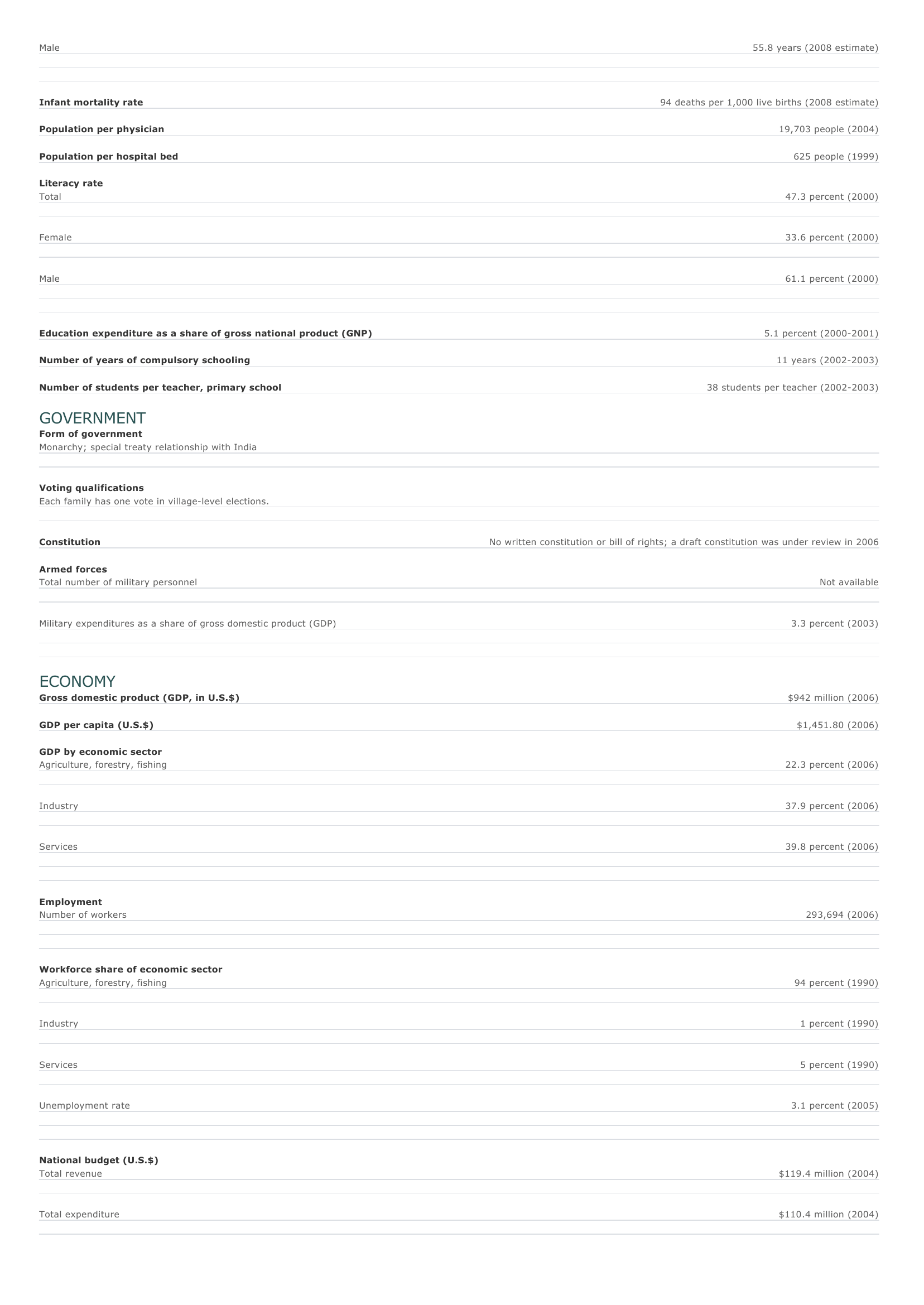Bhutan Facts and Figures. BASIC FACTS Official name Capital Area Kingdom of Bhutan Thimphu 47,000 sq km 18,100 sq mi PEOPLE Population 682,321 (2008 estimate) Population growth Population growth rate 2.07 percent (2008 estimate) Projected population in 2025 3,294,556 (2025 estimate) Projected population in 2050 4,653,447 (2050 estimate) Population density Urban/rural distribution Share urban Share rural 51 persons per sq km (2008 estimate) 131 persons per sq mi (2008 estimate) 8 percent (2003 estimate) 92 percent (2003 estimate) Largest cities, with population Phuntsholing 45,000 (1997 estimate) Thimphu 35,000 (2003 estimate) Ethnic groups Bhutia 50 percent Ethnic Nepalese 35 percent S harchops 10 percent Indigenous or migrant groups 5 percent Languages Dzongkha (official); the Bhutia speak various Tibetan dialects; the Nepalese speak various Nepalese dialects. Religious affiliations Buddhist 74 percent Hindu 21 percent Indigenous beliefs 4 percent O ther 1 percent HEALTH AND EDUCATION Life expectancy Total 55.6 years (2008 estimate) Female 55.4 years (2008 estimate) Male Infant mortality rate Population per physician Population per hospital bed 55.8 years (2008 estimate) 94 deaths per 1,000 live births (2008 estimate) 19,703 people (2004) 625 people (1999) Literacy rate Total 47.3 percent (2000) Female 33.6 percent (2000) Male 61.1 percent (2000) Education expenditure as a share of gross national product (GNP) Number of years of compulsory schooling Number of students per teacher, primary school 5.1 percent (2000-2001) 11 years (2002-2003) 38 students per teacher (2002-2003) GOVERNMENT Form of government Monarchy; special treaty relationship with India Voting qualifications Each family has one vote in village-level elections. Constitution No written constitution or bill of rights; a draft constitution was under review in 2006 Armed forces Total number of military personnel Military expenditures as a share of gross domestic product (GDP) Not available 3.3 percent (2003) ECONOMY Gross domestic product (GDP, in U.S.$) GDP per capita (U.S.$) $942 million (2006) $1,451.80 (2006) GDP by economic sector Agriculture, forestry, fishing 22.3 percent (2006) I ndustry 37.9 percent (2006) Services 39.8 percent (2006) Employment Number of workers Workforce share of economic sector Agriculture, forestry, fishing 293,694 (2006) 94 percent (1990) I ndustry 1 percent (1990) Services 5 percent (1990) Unemployment rate 3.1 percent (2005) National budget (U.S.$) Total revenue $119.4 million (2004) Total expenditure $110.4 million (2004) Monetary unit 1 ngultrum (Nu), consisting of 100 chetrum; Indian currency is also legally used. Major trade partners for exports India, Bangladesh Major trade partners for imports India, Bangladesh, Dominican Republic, United Kingdom, Pakistan ENERGY, COMMUNICATIONS, AND TRANSPORTATION Electricity production Electricity from thermal sources Electricity from hydroelectric sources 0.05 percent (2003 estimate) 99.95 percent (2003 estimate) Electricity from nuclear sources 0 percent (2003 estimate) Electricity from geothermal, solar, and wind sources 0 percent (2003 estimate) Number of radios per 1,000 people 19 (1997) Number of telephones per 1,000 people 51 (2005) Number of televisions per 1,000 people 6.8 (2000 estimate) Number of Internet hosts per 10,000 people Daily newspaper circulation per 1,000 people Number of motor vehicles per 1,000 people Paved road as a share of total roads 13 (2003) Not available 16 (2002) 62 percent (2003) SOURCES Basic Facts and People sections Area data are from the statistical bureaus of individual countries. Population, population growth rate, and population projections are from the United States Census Bureau, International Programs Center, International Data Base (IDB) (www.census.gov). Urban and rural population data are from the Food and Agriculture Organization (FAO) of the United Nations (UN), FAOSTAT database (www.fao.org). Largest cities population data and political divisions data are from the statistical bureaus of individual countries. Ethnic divisions and religion data are largely from the latest Central Intelligence Agency (CIA) World Factbook and from various country censuses and reports. Language data are largely from the Ethnologue, Languages of the World, Summer Institute of Linguistics International (www.sil.org). Health and Education section Life expectancy and infant mortality data are from the United States Census Bureau, International Programs Center, International database (IDB) (www.census.gov). Population per physician and population per hospital bed data are from the World Health Organization (WHO) (www.who.int). Education data are from the United Nations Educational, Scientific and Cultural Organization (UNESCO) database (www.unesco.org). Government section Government, independence, legislature, constitution, highest court, and voting qualifications data are largely from various government Web sites, the latest Europa World Yearbook, and the latest Central Intelligence Agency (CIA) World Factbook. The armed forces data is from Military Balance. Economy section Gross domestic product (GDP), GDP per capita, GDP by economic sectors, employment, and national budget data are from the World Bank database (www.worldbank.org). Monetary unit, agriculture, mining, manufacturing, exports, imports, and major trade partner information is from the statistical bureaus of individual countries, latest Europa World Yearbook, and various United Nations and International Monetary Fund (IMF) publications. Energy, Communication, and Transportation section Electricity information is from the Energy Information Administration (EIA) database (www.eia.doe.gov). Radio, telephone, television, and newspaper information is from the United Nations Educational, Scientific and Cultural Organization (UNESCO) database (www.unesco.org). Internet hosts, motor vehicles, and road data are from the World Bank database (www.worldbank.org). Note Figures may not total 100 percent due to rounding. Microsoft ® Encarta ® 2009. © 1993-2008 Microsoft Corporation. All rights reserved.

































